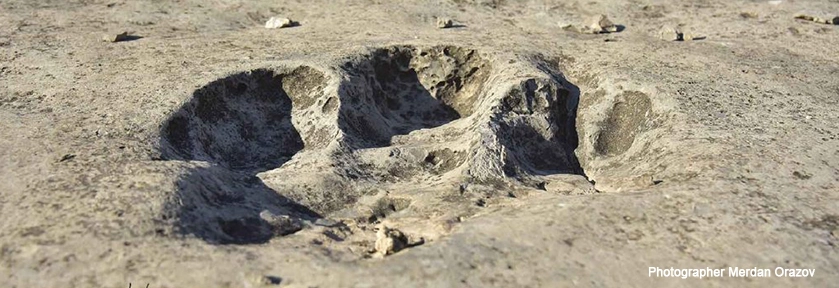In the southeastern part of Turkmenistan, amidst stunning landscapes of the Kugitang Mountains (known as Koytendag in Turkmen), lies an incredible place known as the Dinosaur Plateau.
It's located near the village of Khodjapil, which means "holy elephants" in Turkmen. An interesting story has been preserved here. Local tales say that the tracks left by dinosaurs in this area were once believed to be the footprints of Alexander the Great and his army's elephants. The connection between the village's name, the legend, and the peculiar tracks has captured the attention of locals for generations.
This initial discovery intrigued local historians and geologists. They documented their findings in the latter half of the past century. Over time, this news spread within the scientific community of the USSR. Scholars from the Paleontological Institute and the Institute of Geology of the USSR Academy of Sciences, as well as university students, began to study the plateau.
Dinosaur Plateau in Turkmenistan
The Dinosaur Plateau measures about 400 meters in length and 300 meters in width. It houses an astonishing collection of around 3,000 well-preserved dinosaur tracks, forming 31 distinct trails. Such a concentration of dinosaur tracks in one place is truly unique. Among these tracks, 26 were left by megalosaurs, and the longest trail spans an impressive 311 meters. This surpasses the previous "world record" of 147 meters found in Portugal. It's particularly noteworthy that the megalosaur tracks are the largest known from the Jurassic period. All these remarkable features make the Dinosaur Plateau in Turkmenistan - a truly unparalleled wonder.
Megalosaurs were large carnivorous dinosaurs with big heads, long jaws, and sharp teeth. They walked on powerful hind legs with four toes, one of which had a special claw on the back. These dinosaurs moved on two legs, with shorter front limbs that had three fingers. The tracks they left could reach lengths of up to 70 cm and widths of 65 cm, with strides of over two meters. On the plateau, you can also spot tracks of smaller dinosaurs, often moving in groups of three.
The history of the Dinosaur Plateau dates back millions of years. At the time, the land they walked on was likely swampy terrain near the coast. This environment was ideal for preserving deep tracks of hunting dinosaurs that were tracking small prey. Over time, the swamp turned into solid rock, preserving these secrets. Geological processes gradually lifted and tilted this region during mountain formation. Subsequent rains and erosion gradually unveiled this incredible paleontological treasure, offering us a remarkable glimpse into the distant past.
The Dinosaur Plateau in Turkmenistan - invites us to look into the past, a place where giant creatures once roamed.

